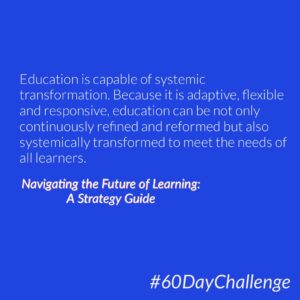 Back in posts #3 and #23, I introduced KnowledgeWorks Forecast 5.0. Before we hit the end of our #60DayChallenge, I wanted to touch on some of the provocations created by reviewing the Forecast’s accompanying Strategy Guide.
Back in posts #3 and #23, I introduced KnowledgeWorks Forecast 5.0. Before we hit the end of our #60DayChallenge, I wanted to touch on some of the provocations created by reviewing the Forecast’s accompanying Strategy Guide.
Here’s how KnowledgeWorks introduces the Guide on their site:
Navigating the Future of Learning: A Strategy Guide is organized into five opportunity areas for building effective strategies and offers examples of strategies that stakeholders might adopt, along with associated tactics. These strategies and tactics are intended as starting points that can be modified, adapted and developed to suit the unique visions of individual organizations, communities and states. This strategic guidance reflects insights and issues drawn from workshops with current learners and education leaders, innovators and influencers of K-12 school-based education, postsecondary education and community-based learning programs.
To help education stakeholders realize their visions for the future, this guide closes with a series of broad insights that can inform how stakeholders talk to their communities about change and how they go about implementing their chosen strategies.
In their collaboration with other education stakeholders to create the Guide, six (6) qualities emerged as key elements of a vision for the future of schooling:
Learning is human-centered. It prioritizes healthy human development, joyful experiences and positive relationships. It supports individual practices of resilience and adaptation.All these hallmarks are foundational for encouraging lifelong learning and for navigating uncertain, complex futures.
Learning is equitable, comprehensive and inclusive. Education promotes meaningful teaching, learning and development across life stages for all community members through equitable access to resources, relationships and opportunities.
Learning pathways are limitless. Recognizing learners’ diversity, distinct needs and aspirations, learning pathways are as varied and valid as students. No learners reach dead ends, and no single pathway represents the only path toward success.
Education is structured and governed as an ecosystem. It is comprised of diverse actors and stakeholders interacting with one another through robust, adaptive networks and exchanging resources and expertise to produce meaningful, sustainable learning opportunities for all its members.
Education decision-makers balance short-term needs with long-term aspirations. Stewardship of the learning ecosystem recognizes the immediate needs of learners and institutions while building capacity for future adaptation and relevance.
Education is capable of systemic transformation. Because it is adaptive, flexible and responsive, education can be not only continuously refined and reformed but also systemically transformed to meet the needs of all learners.
—–
❓ Provocations:
Which of the qualities resonate with your vision for the future of schooling? Why do you think so? Based on the provocations and conversation over the past 50 days, what would you add to the list of qualities?
💎 Resource:
After-Shock Review: The Future of Forecasting
🧠 Mindsets:
Futures
💡 Areas:
Leadership
📣 Drop your thoughts in the comments, or in the Facebook group, and feel free to share resources. 🔥🔥🔥
- A silver lining - January 22, 2022
- Is our use of tech working against us? 🤔 - September 8, 2021
- What’s NOT going to change in the next 10 years? 🤔 - September 7, 2021